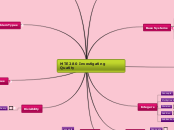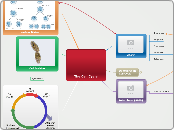MTE 280 Investigating Quatity
Fractions
Addition:Use the are, set, or linear model
Subtraction: Use the are, set, or linear model (cross off pieces to show that you are taking them away)
Multiplication: Usually use the area model (although you can use set and linear model but you probably wont have a fun?easy time with that)
*1/2 x 3/4 (1/2 of a group of 3/4)
Division: Usually use the linear model (although you can use set and linear model but you probably wont have a fun?easy time with that)
*For addition and subtraction you need to make the denominators the same number so you create equivalent fractions
Divisibility
Number Theory
Divisibility Test
A number is divisible by 2 if the last digit is 0, 2, 4, 6 or 8.
A number is divisible by 3 if the sum of the digits is divisible by 3.
A number is divisible by 4 if the number formed by the last two digits is divisible by 4.
A number is divisible by 5 if the last digit is either 0 or 5.
A number is divisible by 6 if it is divisible by 2 AND it is divisible by 3.
A number is divisible by 8 if the number formed by the last three digits is divisible by 8.
A number is divisible by 9 if the sum of the digits is divisible by 9.
A number is divisible by 10 if the last digit is 0.
Factor Rainbow
A factor rainbow is a rainbow-shaped diagram that factors of a number in pairs
Property Types
Zero Property
*Zero Property of Multiplication: Anything multiplied by zero is zero
*a x 0 = 0
Distributive Property
*Distributive Property of multiplication over Addition/Subtraction: ex. 5(3+4) = 5 x 3+5 x 4
*Distributive Property of Multiplication over Subtraction for Whole Numbers: a(b - c) = ab - ac
*Distributive Property of Multiplication over Addition for Whole Numbers: a(b+c) = ab + ac
*Distributive Property DOES NOT work for division
Identity Property
*Property for Addition AND Multiplication
*Addition: a+0=a
*Multiplication: a x 1 = a = 1 x a
Addition: When adding a zero to any number, the sums stays the same
Multiplication: When multiplying 1 to any number, the quotient stays the same
Closure Property
*Works for Addition AND Multiplication
*Addition: If you add any two whole numbers, the sum will be a whole number
*Multiplication: If you multiply any two whole numbers, the quotient will be a whole number
Associative Property
*Property for Addition AND Multiplication
* a+(b+c) = (a+b)+c OR a x (b x c) = (a x b) x c
Addition: When adding three or more numbers, the grouping of the numbers will not change the sum
Multiplication: When multiplying three or more numbers, the grouping of the numbers will not change the quotient
Commutative Property
*Property for multiplication AND addition
*(a+b)=(b+a) and (a x b)=(b x a)
*Addition: Changing the order of the addends will result in the same sum
*Multiplication: Changing the order of the factors will result in the same sum.
Addend: Numbers in an addition problem
Factors: Numbers in a multiplication problem
Problem Types
*Partition: Diving a group of numbers into smaller equal groups
*Missing Factor: Using a related multiplication fact to find the answer
*Repeated Subtraction: Subtracting the number that we want to divide by its dividend the same number of times as the quantity of the dividend to reach the final answer
*Repeated-Addition: Putting equal-sized groups together to reach a quotient
*Rectangular array and Area Model: Objects are arranged with the same number of objects in each row
*Cartesian: Creating a tree diagram to show numerous outcomes of the product
*Take Away: Starting with an initial quantity and removing a specified amount
*Missing Addend: The need to figure out what quantity must be added to a specified quantity to reach a target amount
*Comparison Problem: Comparison of the relative sizes of 2 quantities to determine how much smaller or larger one is than the other
*Linear: On a number line using arrows to show a change
*Set Model: The combining of two sets of discrete objects (individually different and distinct objects)
*Linear/Number line Model: Combining two continuous quantities (measured quantities like time, distance, quantity, etc). Shown on a number line to show the change.
Algorithms
* Partial Products
*Lattice
*Using base 10 blocks to create a concrete model for subtraction.
*Equal-Additions: The difference between two numbers does not change if the same amount is added to both numbers
*Trade First
*Counting Up
*Partial Differences
*Children use manipulatives, which are physical items that they can interact with to create their own algorithms.
*Left-to-Right: Adding from left to right. Adding the larger pieces then the smaller ones.
*Lattice: Add single digit numbers by place value on top to the single digit numbers on bottom then add the sums from the diagonals.
Scratch: Adding complicated additions by adding only two single digits
Expanded Notation: Separating a larger number into smaller components that still equal the same number when added
Compensation: Adding a number that does not exist
Partial Sums: Sum of part of the sequence
*Given any whole numbers, a and b with be not equaling zero, there exist unique whole numbers q (quotient) and r (remainder) such that a = bq + r with 0 < r < b.
*Partial Quotients
*Column Division
Decimals
Operations
Addition: Line up the decimals
Subtraction: Line up the decimals
Multiplication:
- Whole X Decimal
- Decimal X Whole
- Decimal X Decimal
Division:
- Partition (number of groups)
- Measurement (How many in each group?)
Use base 10 blocks
- Unit 1/100
- long 1/10
- flat 1
- cube 10
Comparing
- Expanded form
- Word form
- Standard Form
- Base 10
Terminating: Comes to an end
Non-Terminating: Repeats
Integers
Subtraction
Addition
Division
Multiplication
Number line Model: used to represent positive and negative quantities, and the number line model can illustrate properties of signed arithmetic.
Pattern Model: The first digit of the sequence stays consistent while the digit being added changes each time the pattern is repeated, until reaching the opposite of the sum
Charged Field Model: Positive and negative charges are used just like a chip model, and the field has 0 charged if it has the same number of positive and negative charges.
Chip Model: Positive integers are represented with black chips and the negative charges are represented with red chips. A red chip can neutralize a black chip
Concepts
Integer Concepts:
Chip Method: When modeling integers, we can use colored chips to represent integers. One color can represent a positive number and another color can represent a negative number
Number Line: A number line can be used to represent positive and negative quantities, and the number line model can illustrate properties of signed arithmetic.
Absolute Value: The absolute value of x, denoted "| x |" (and which is read as "the absolute value of x"), is the distance of x from zero.
Digits
Digits: Set of singular numbers --> (1,2,3,4,5,6,7,8,9)
* Digits are the foundation of ALL numbers
Base Systems
Base 12
*System primarily used by African tribes
*"1..2..3..4..5..6..7..8..9..x..3..10"
*3(Backwards 3): El
*x: Dec
*10 is ACTUALLY 12 in this sytem
Base 5
* Contains 5 digits
*"0..1..2..3..4"
Base 2
*Known as the binary system
*Contains the numbers 1 & 2
*"0..1.."
Base 10
Hindu Arabic- Known as the U.S. version of the base system
*There are 10 digits in this system
*System goes up to number 9 --> (0,1,2,3,4,5,6,7,8,9)
Algorithms Vs. Strategies
Strategy: A method or trick to help students comprehend math
Algorithm: A step-by-step solution
Strategies:
Decomposition: Separating numbers into their components (To divide a number into smaller parts
Comprehension: Understanding concepts, operations, and relations
Open Number line: Visual representation for recording and sharing students' thinking strategies during the process of mental computation
Base 10 Blocks/Pictures: Strategy used for visual representation while working through math problems such as: addition, multiplication, subtraction, division, etc. This strategy greatly helps children who cannot understand how to work through a problem fully as the blocks or pictures allows them to visually see the quantity of a number
Algorithms
Partial Sums: The sum of part of a sequence (a set of numbers that is in order)
Expanded Notation: Writing a number to show the value of each digit
Standard Notation: Number is completely written out using numerical digits









